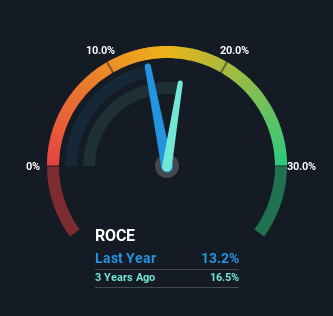- India
- /
- Telecom Services and Carriers
- /
- NSEI:TATACOMM
Tata Communications (NSE:TATACOMM) Is Experiencing Growth In Returns On Capital
If you're looking for a multi-bagger, there's a few things to keep an eye out for. In a perfect world, we'd like to see a company investing more capital into its business and ideally the returns earned from that capital are also increasing. Ultimately, this demonstrates that it's a business that is reinvesting profits at increasing rates of return. Speaking of which, we noticed some great changes in Tata Communications' (NSE:TATACOMM) returns on capital, so let's have a look.
What Is Return On Capital Employed (ROCE)?
Just to clarify if you're unsure, ROCE is a metric for evaluating how much pre-tax income (in percentage terms) a company earns on the capital invested in its business. To calculate this metric for Tata Communications, this is the formula:
Return on Capital Employed = Earnings Before Interest and Tax (EBIT) ÷ (Total Assets - Current Liabilities)
0.13 = ₹18b ÷ (₹252b - ₹113b) (Based on the trailing twelve months to September 2024).
So, Tata Communications has an ROCE of 13%. That's a relatively normal return on capital, and it's around the 15% generated by the Telecom industry.
See our latest analysis for Tata Communications

Above you can see how the current ROCE for Tata Communications compares to its prior returns on capital, but there's only so much you can tell from the past. If you're interested, you can view the analysts predictions in our free analyst report for Tata Communications .
So How Is Tata Communications' ROCE Trending?
We like the trends that we're seeing from Tata Communications. The data shows that returns on capital have increased substantially over the last five years to 13%. The company is effectively making more money per dollar of capital used, and it's worth noting that the amount of capital has increased too, by 23%. So we're very much inspired by what we're seeing at Tata Communications thanks to its ability to profitably reinvest capital.
On a side note, Tata Communications' current liabilities are still rather high at 45% of total assets. This effectively means that suppliers (or short-term creditors) are funding a large portion of the business, so just be aware that this can introduce some elements of risk. Ideally we'd like to see this reduce as that would mean fewer obligations bearing risks.
The Key Takeaway
All in all, it's terrific to see that Tata Communications is reaping the rewards from prior investments and is growing its capital base. Since the stock has returned a staggering 413% to shareholders over the last five years, it looks like investors are recognizing these changes. With that being said, we still think the promising fundamentals mean the company deserves some further due diligence.
On a final note, we've found 3 warning signs for Tata Communications that we think you should be aware of.
While Tata Communications may not currently earn the highest returns, we've compiled a list of companies that currently earn more than 25% return on equity. Check out this free list here.
Valuation is complex, but we're here to simplify it.
Discover if Tata Communications might be undervalued or overvalued with our detailed analysis, featuring fair value estimates, potential risks, dividends, insider trades, and its financial condition.
Access Free AnalysisHave feedback on this article? Concerned about the content? Get in touch with us directly. Alternatively, email editorial-team (at) simplywallst.com.
This article by Simply Wall St is general in nature. We provide commentary based on historical data and analyst forecasts only using an unbiased methodology and our articles are not intended to be financial advice. It does not constitute a recommendation to buy or sell any stock, and does not take account of your objectives, or your financial situation. We aim to bring you long-term focused analysis driven by fundamental data. Note that our analysis may not factor in the latest price-sensitive company announcements or qualitative material. Simply Wall St has no position in any stocks mentioned.
About NSEI:TATACOMM
Established dividend payer with reasonable growth potential.
Similar Companies
Market Insights
Community Narratives




